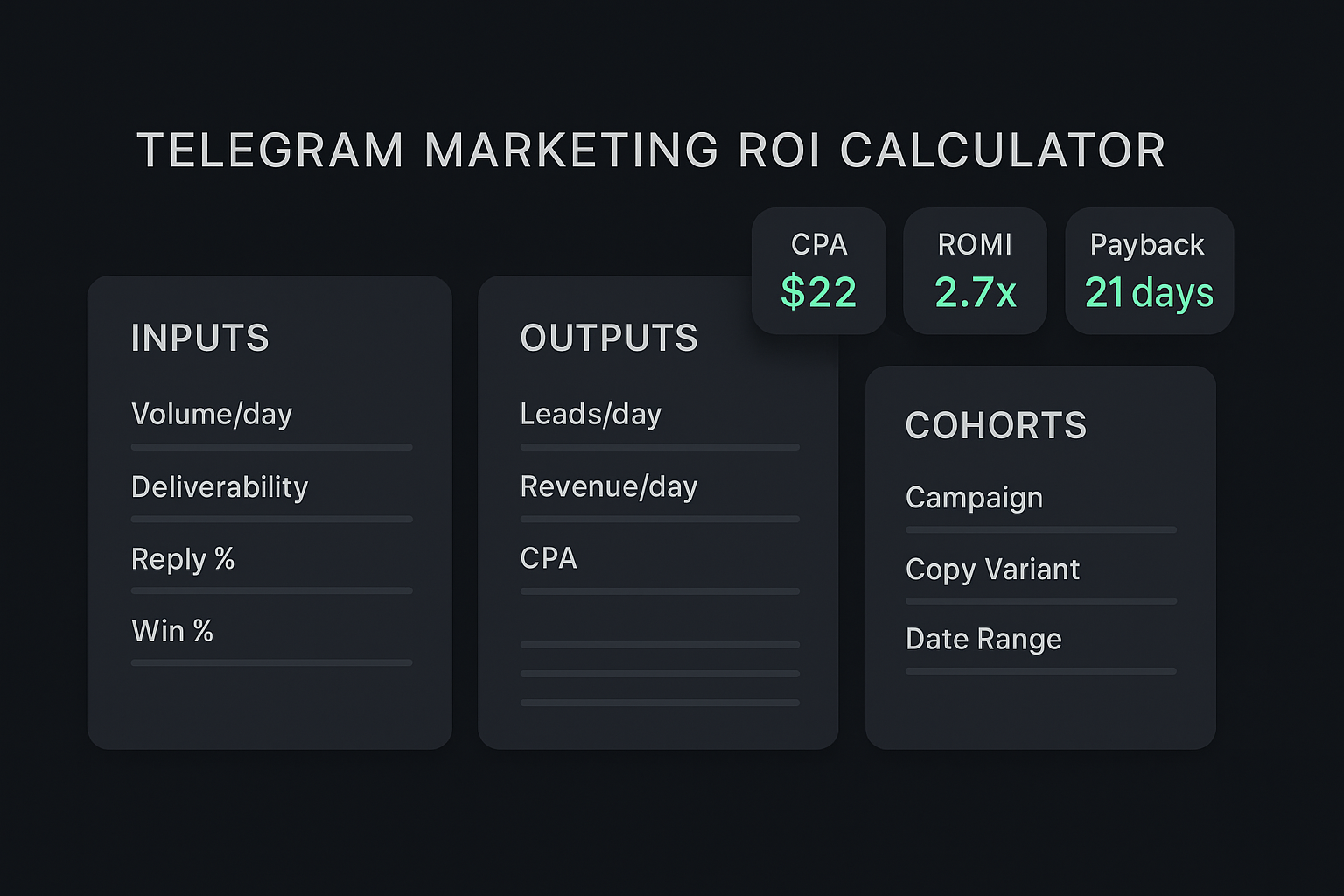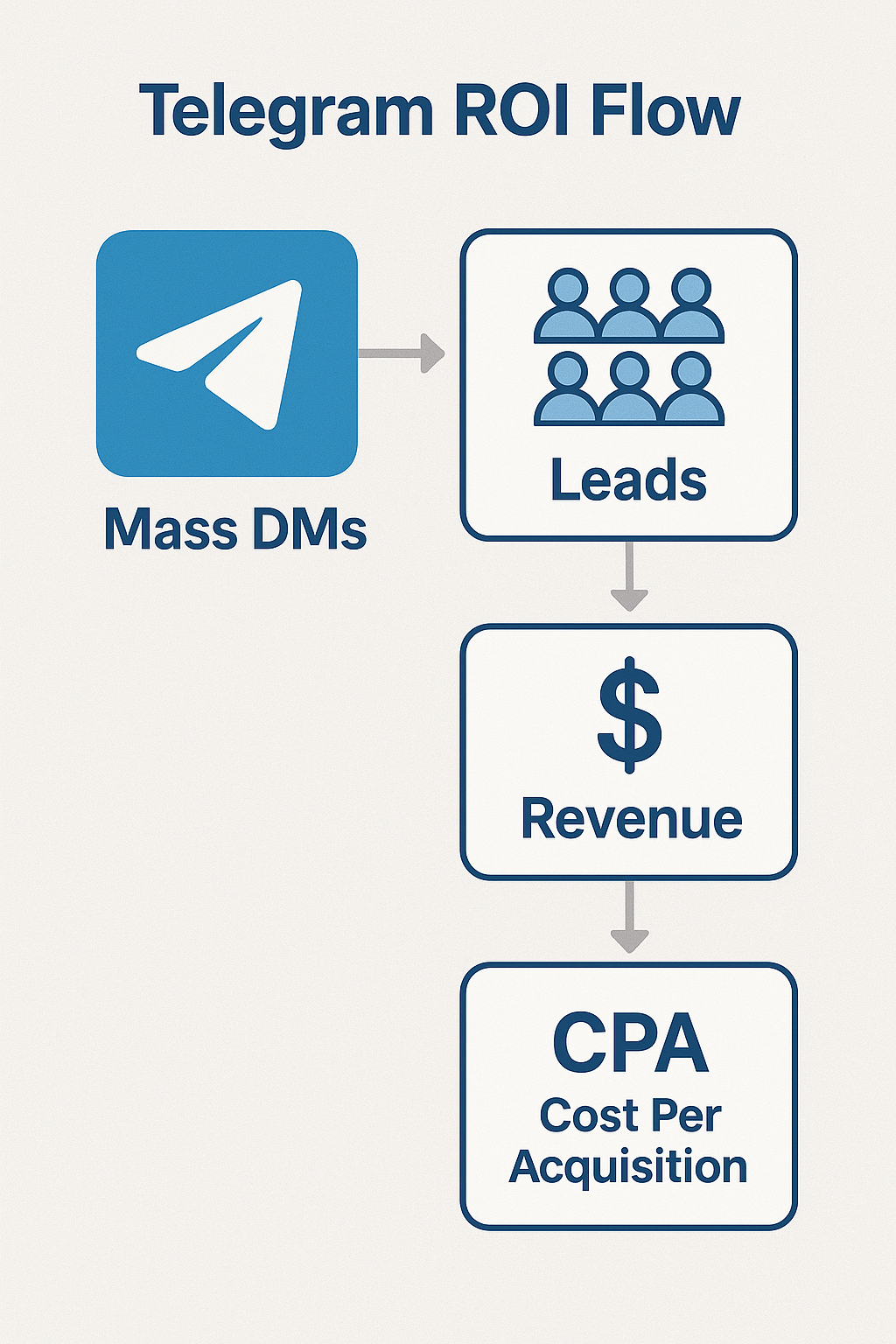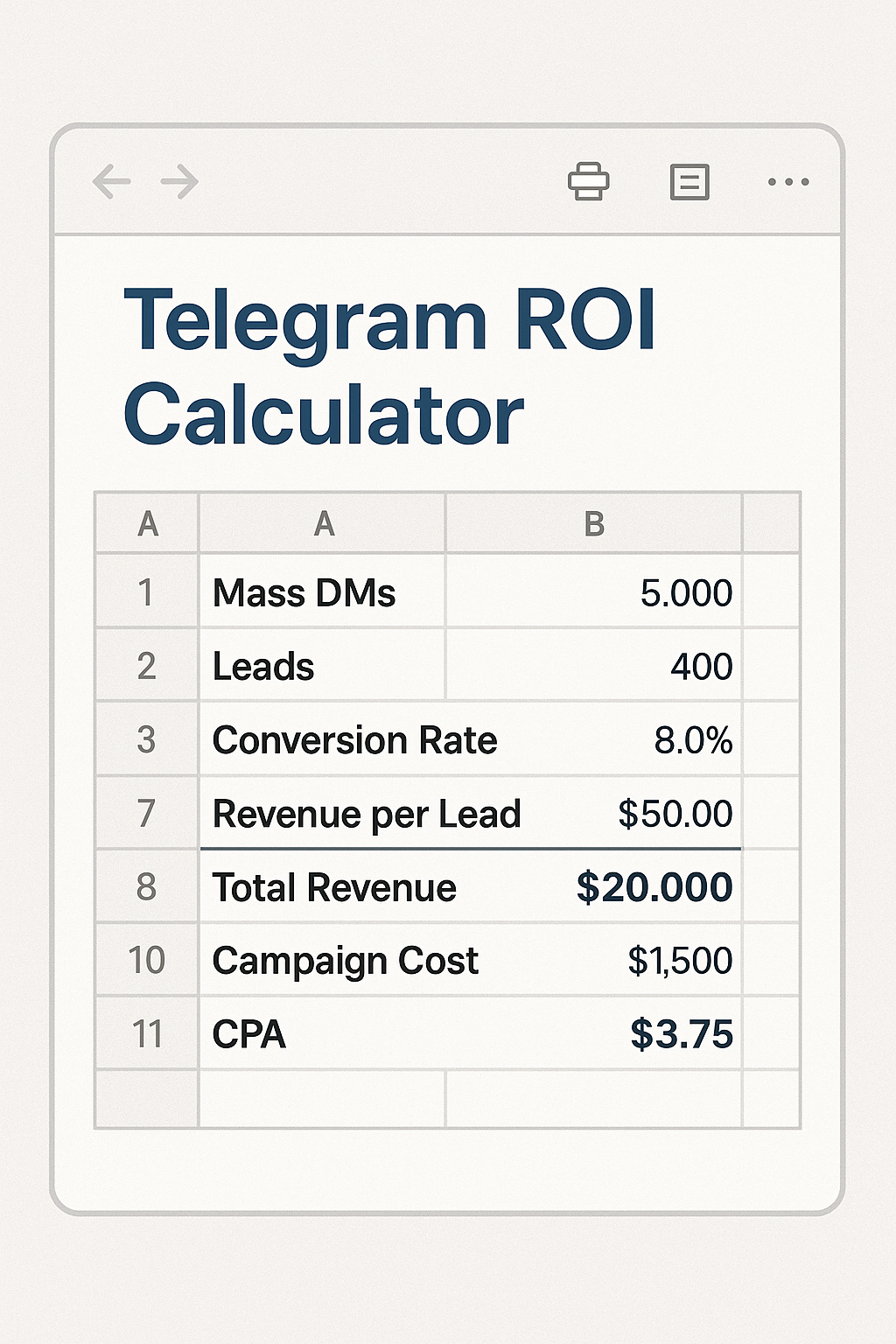Telegram ROI Calculator: Leads, Revenue & CPA [Sheet]

Primary keyword: telegram marketing roi
Use this free, practical Telegram marketing ROI framework to forecast leads, CPA, revenue, and payback for your campaigns. The included sheet and CSV template help you move from gut feeling to data-backed planning. Whether you run a one-off test or a scaled campaign, you’ll model the numbers that matter, detect constraints early, and align the playbook with your revenue target.
What you’ll get
- A simple but powerful ROI calculator tailored to Telegram outreach.
- A plug-and-play lead tracking sheet for cohorts and testing.
- A clean CPA model with sensitivity toggles (reply rate, close rate, AOV).
- A step-by-step revenue projection you can present to stakeholders.

How the calculator works (inputs → outputs)
At its core, the model tracks a clean funnel: Profiled Audience → Delivered Messages → Replies → Qualified Leads → Opportunities → Closed-Won Revenue. You control the inputs and the calculator outputs ROI metrics in real time.
Inputs you can adjust
- Volume: messages sent per day and total cohort size.
- Deliverability: percent of messages that land successfully.
- Engagement: reply rate and qualified-lead rate from replies.
- Sales: opportunity rate, win rate, average order value (AOV), and sales cycle in days.
- Costs: account/software costs, labor, proxy/infra, and per-message operational cost.
Outputs you’ll see
- Leads & Revenue: daily/weekly/monthly lead count and booked revenue.
- CPA & CPL: cost per acquisition and cost per lead by cohort.
- ROMI / ROI: return on marketing investment and payback period.
- Break-even volume: minimum daily sends to hit neutral cash flow.
Quick start in 8 minutes
- Open the Telegram DM ROI calculator (Google Sheet link or CSV template).
- Enter your offer, audience niche, and the test window (e.g., 14 days).
- Set volume (messages/day) and deliverability assumptions.
- Add reply rate and qualified-lead rate (start conservative: 3–5% replies, 30–50% qualified).
- Define opportunity and win rates (e.g., 40% & 20%).
- Input costs: accounts/software, proxies, labor, per-message operational cost.
- Check outputs: CPA, revenue projection, and payback.
- Export a snapshot as CSV for your weekly review and test iteration.
Benchmarks to calibrate your first run
- Deliverability: 85–95% (with warmed accounts and safe throttling).
- Reply rate: 2–6% (varies by niche and copy quality).
- Qualified-lead rate (from replies): 30–60%.
- Opportunity rate (from qualified): 30–50%.
- Win rate (from opportunities): 15–30% for mid-ticket B2B; wider range for B2C.
These are starting points. Track your cohorts in the lead tracking sheet and let the data pull your assumptions toward reality.

Template structure (tabs & fields)
1) Inputs (edit)
- Volume/day, total days, deliverability %
- Reply %, qualified-lead %, opportunity %, win %
- AOV, variable cost/order, fixed costs (accounts, proxies, labor)
- Sales cycle (days) for payback curve
2) Outputs (auto)
- Leads/day, revenue/day, revenue cumulative
- CPL, CPA, CAC payback (days)
- ROMI, ROI, break-even sends
3) Cohorts (edit)
- Campaign, audience, copy variant, date range
- Sends, deliveries, replies, qualified, opportunities, won
- Commentary (what changed, what worked)
4) Costs (edit)
- Per-message variable cost
- Fixed infra/month (accounts, proxies, software, labor)
Formulas you can copy
Delivered = Sends × Deliverability% Replies = Delivered × Reply% Qualified Leads = Replies × Qualified% Opportunities = Qualified Leads × Opportunity% Customers (Won) = Opportunities × Win% Revenue = Customers × AOV CPL = Total Cost ÷ Qualified Leads CPA = Total Cost ÷ Customers ROMI = (Revenue − Total Cost) ÷ Total Cost Payback (days) ≈ (CAC ÷ Gross Profit/Day) + Sales Cycle Offset
How to lower CPA fast
- Upgrade data quality: filter for last-seen recent, profile photo, and premium — start with smaller, higher-intent cohorts.
- Tighten the offer: one problem, one promise, one CTA. Reduce friction and remove extra links.
- Iterate copy weekly: A/B opener + angle; keep the CTA constant to learn faster.
- Improve deliverability: warmed accounts, safe throttling, randomized delays, and realistic profiles.
- Route fast: same-day follow-ups convert more leads into pipeline, reducing effective CPA.
Lead tracking discipline (the part most teams skip)
The calculator is only as good as your inputs. Use the lead tracking sheet to tag cohorts by audience, copy variant, and week. Each Friday, export a CSV snapshot and compare: which niche + angle pair delivered the best telegram campaign cpa and the highest telegram revenue projection?
When to scale
- Hit target CPA for two consecutive cohorts.
- Confirm payback within your cash-flow window.
- Lock the ICP + angle, then add accounts and raise daily volume slowly.
Grab the templates
- Google Sheet: Duplicate and start modeling your telegram marketing roi today.
- CSV: Import into your BI tool or CRM to sync cohorts with revenue.
Related resources
- Mass DM & Targeted Outreach — data-driven sending with compliance and reporting.
- Pricing — compare packages and choose a test size that fits your goals.
- Contact — want help building your model or running the test?
Final word
Forecasts don’t win deals — iterations do. Use this calculator to pick the highest-leverage test, run it for two weeks, then double down where your telegram dm roi calculator shows the strongest ROMI. If you’d like hands-on help, our team can set up the model, execute outreach, and report on the full funnel end-to-end.
 Telegram Solutions
Telegram Solutions